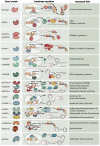Epigenetic regulation of autophagy-related genes: Implications for neurodevelopmental disorders
- PMID: 37674294
- PMCID: PMC10761153
- DOI: 10.1080/15548627.2023.2250217
Epigenetic regulation of autophagy-related genes: Implications for neurodevelopmental disorders
Abstract
Macroautophagy/autophagy is an evolutionarily highly conserved catabolic process that is important for the clearance of cytosolic contents to maintain cellular homeostasis and survival. Recent findings point toward a critical role for autophagy in brain function, not only by preserving neuronal health, but especially by controlling different aspects of neuronal development and functioning. In line with this, mutations in autophagy-related genes are linked to various key characteristics and symptoms of neurodevelopmental disorders (NDDs), including autism, micro-/macrocephaly, and epilepsy. However, the group of NDDs caused by mutations in autophagy-related genes is relatively small. A significant proportion of NDDs are associated with mutations in genes encoding epigenetic regulatory proteins that modulate gene expression, so-called chromatinopathies. Intriguingly, several of the NDD-linked chromatinopathy genes have been shown to regulate autophagy-related genes, albeit in non-neuronal contexts. From these studies it becomes evident that tight transcriptional regulation of autophagy-related genes is crucial to control autophagic activity. This opens the exciting possibility that aberrant autophagic regulation might underly nervous system impairments in NDDs with disturbed epigenetic regulation. We here summarize NDD-related chromatinopathy genes that are known to regulate transcriptional regulation of autophagy-related genes. Thereby, we want to highlight autophagy as a candidate key hub mechanism in NDD-related chromatinopathies.Abbreviations: ADNP: activity dependent neuroprotector homeobox; ASD: autism spectrum disorder; ATG: AutTophaGy related; CpG: cytosine-guanine dinucleotide; DNMT: DNA methyltransferase; EHMT: euchromatic histone lysine methyltransferase; EP300: E1A binding protein p300; EZH2: enhancer of zeste 2 polycomb repressive complex 2 subunit; H3K4me3: histone 3 lysine 4 trimethylation; H3K9me1/2/3: histone 3 lysine 9 mono-, di-, or trimethylation; H3K27me2/3: histone 3 lysine 27 di-, or trimethylation; hiPSCs: human induced pluripotent stem cells; HSP: hereditary spastic paraplegia; ID: intellectual disability; KANSL1: KAT8 regulatory NSL complex subunit 1; KAT8: lysine acetyltransferase 8; KDM1A/LSD1: lysine demethylase 1A; MAP1LC3B: microtubule associated protein 1 light chain 3 beta; MTOR: mechanistic target of rapamycin kinase; MTORC1: mechanistic target of rapamycin complex 1; NDD: neurodevelopmental disorder; PHF8: PHD finger protein 8; PHF8-XLID: PHF8-X linked intellectual disability syndrome; PTM: post-translational modification; SESN2: sestrin 2; YY1: YY1 transcription factor; YY1AP1: YY1 associated protein 1.
Keywords: Autophagy related gene expression; chromatinopathies; epigenetics; neurodevelopmental disorders; neuronal autophagy.
Conflict of interest statement
No potential conflict of interest was reported by the authors.
Figures
Similar articles
-
Analysis of a Set of KDM5C Regulatory Genes Mutated in Neurodevelopmental Disorders Identifies Temporal Coexpression Brain Signatures.Genes (Basel). 2021 Jul 18;12(7):1088. doi: 10.3390/genes12071088. Genes (Basel). 2021. PMID: 34356104 Free PMC article.
-
Imbalanced autophagy causes synaptic deficits in a human model for neurodevelopmental disorders.Autophagy. 2022 Feb;18(2):423-442. doi: 10.1080/15548627.2021.1936777. Epub 2021 Jul 21. Autophagy. 2022. PMID: 34286667 Free PMC article.
-
Histone H4K20/H3K9 demethylase PHF8 regulates zebrafish brain and craniofacial development.Nature. 2010 Jul 22;466(7305):503-7. doi: 10.1038/nature09261. Epub 2010 Jul 11. Nature. 2010. PMID: 20622853 Free PMC article.
-
Acetylation in the regulation of autophagy.Autophagy. 2023 Feb;19(2):379-387. doi: 10.1080/15548627.2022.2062112. Epub 2022 Apr 18. Autophagy. 2023. PMID: 35435793 Free PMC article. Review.
-
KDM1A/LSD1 as a promising target in various diseases treatment by regulating autophagy network.Biomed Pharmacother. 2022 Apr;148:112762. doi: 10.1016/j.biopha.2022.112762. Epub 2022 Feb 28. Biomed Pharmacother. 2022. PMID: 35240522 Review.
Cited by
-
ADNP dysregulates methylation and mitochondrial gene expression in the cerebellum of a Helsmoortel-Van der Aa syndrome autopsy case.Acta Neuropathol Commun. 2024 Apr 18;12(1):62. doi: 10.1186/s40478-024-01743-w. Acta Neuropathol Commun. 2024. PMID: 38637827 Free PMC article.
-
The role of autophagy in pancreatic diseases.Front Pharmacol. 2024 Sep 30;15:1444657. doi: 10.3389/fphar.2024.1444657. eCollection 2024. Front Pharmacol. 2024. PMID: 39403146 Free PMC article. Review.
-
Evaluating the Role of Susceptibility Inducing Cofactors and of Acetaminophen in the Etiology of Autism Spectrum Disorder.Life (Basel). 2024 Jul 23;14(8):918. doi: 10.3390/life14080918. Life (Basel). 2024. PMID: 39202661 Free PMC article.
-
Tranylcypromine upregulates Sestrin 2 expression to ameliorate NLRP3-related noise-induced hearing loss.Neural Regen Res. 2025 May 1;20(5):1483-1494. doi: 10.4103/NRR.NRR-D-24-00130. Epub 2024 Jun 26. Neural Regen Res. 2025. PMID: 39075914 Free PMC article.
-
Knockout of bcas3 gene causes neurodevelopment defects in zebrafish.Biol Res. 2025 Jun 6;58(1):34. doi: 10.1186/s40659-025-00615-4. Biol Res. 2025. PMID: 40481608 Free PMC article.
References
Publication types
MeSH terms
Substances
LinkOut - more resources
Full Text Sources
Medical
Research Materials
Miscellaneous


